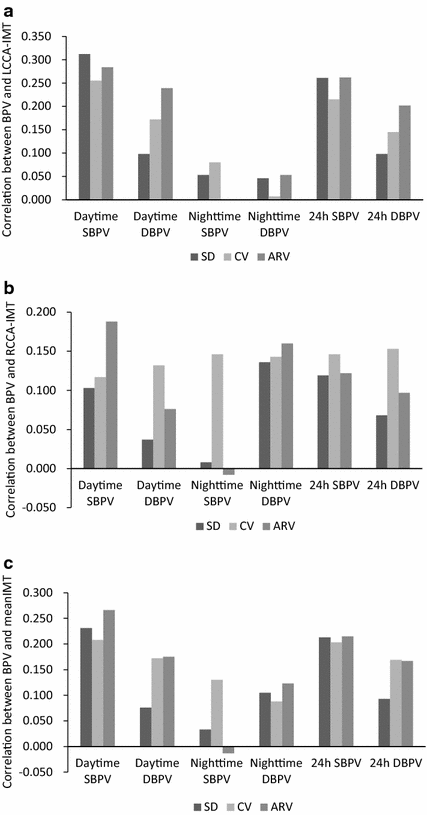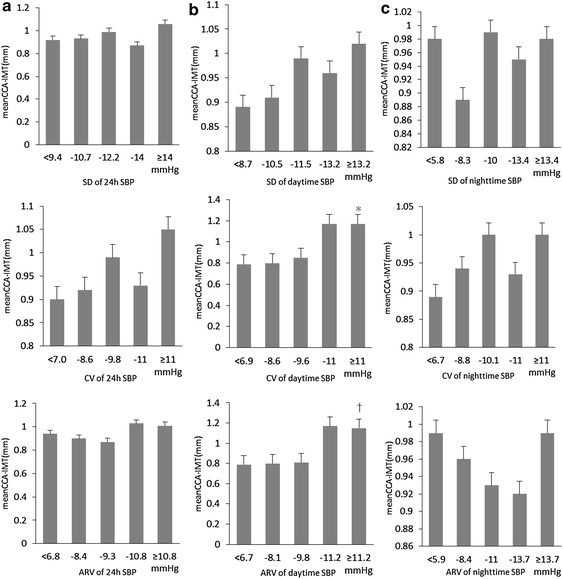Relationship of short-term blood pressure variability with carotid intima-media thickness in hypertensive patients
- PMID: 26204889
- PMCID: PMC4511984
- DOI: 10.1186/s12938-015-0059-8
Relationship of short-term blood pressure variability with carotid intima-media thickness in hypertensive patients
Abstract
Background: High blood pressure (BP) is among significant risk factor for stroke and other vascular occurrences, it experiences nonstop fluctuations over time as a result of a complex interface among cardiovascular control mechanisms. Large blood pressure variability (BPV) has been proved to be promising in providing potential regulatory mechanisms of the cardiovascular system. Although the previous studies also showed that BPV is associated with increased carotid intima-media thickness (IMT) and plaque, whether the correlation between variability in blood pressure and left common carotid artery-intima-media thickness (LCCA-IMT) is stronger than right common carotid artery-intima-media thickness (RCCA-IMT) remains uncertain in hypertension.
Methods: We conduct a study (78 hypertensive subjects, aged 28-79) to evaluate the relationship between BPV and carotid intima-media thickness in Shenzhen. The blood pressure was collected using the 24 h ambulatory blood pressure monitoring, and its variability was evaluated using standard deviation (SD), coefficient of variation (CV), and average real variability (ARV) during 24 h, daytime and nighttime. All the IMT measurements are collected by ultrasound.
Results: As the results showed, 24 h systolic blood pressure variability (SBPV) evaluated by SD and ARV were significantly related to LCCA-IMT (r(1) = 0.261, P = 0.021; r(1) = 0.262, P = 0.021, resp.). For the daytime diastolic blood pressure variability (DBPV), ARV indices were significantly related to LCCA-IMT (r(1) = 0.239, P = 0.035), which differed form BPV evaluated by SD and CV. For the night time, there is no significant correlation between the BPV and IMT. Moreover, for all the subjects, there is no significant correlation between the BPV and RCCA-IMT/number of plaques, whereas, the SD, CV, and ARV of daytime SBP showed a positive correlation with LCCA-IMT (r(1) = 0.312, P = 0.005; r(1) = 0.255, P = 0.024; r(1) = 0.284, P = 0.012, resp.). Moreover, the ARV of daytime SBPV, 24 h SBPV and nighttime DBPV showed a positive correlation with the number of plaques of LCCA (r(1) = 0.356, P = 0.008; r(1) = 0.297, P = 0.027; r(1) = 0.278, P = 0.040, resp.). In addition, the number of plaques in LCCA had higher correlation with pulse pressure and diastolic blood pressure than that in RCCA. And multiple regression analysis indicated LCCA-IMT might not only be influenced by age or smoking but also by the SD index of daytime SBPV (p = 0.035).
Conclusions: The results show that SBPV during daytime and 24 h had significant correlation with IMT, for the hypertensive subjects from the southern area of China. Moreover, we also found the daytime SBPV to be the best predictor for the progression of IMT in multivariate regression analysis. In addition, the present study suggests that the correlation between BPV and left common carotid artery-intima-media thickness/number of plaques is stronger than right common carotid artery-intima-media thickness/number of plaques.
Figures


Similar articles
-
The relationship between the 24 h blood pressure variability and carotid intima-media thickness: a compared study.Comput Math Methods Med. 2014;2014:303159. doi: 10.1155/2014/303159. Epub 2014 Feb 11. Comput Math Methods Med. 2014. PMID: 24660021 Free PMC article.
-
[Blood pressure variability correlates with target-organ damage in elderly patients with hypertension].Sichuan Da Xue Xue Bao Yi Xue Ban. 2011 Mar;42(2):252-5. Sichuan Da Xue Xue Bao Yi Xue Ban. 2011. PMID: 21500566 Chinese.
-
Influence of blood pressure variability on early carotid atherosclerosis in hypertension with and without diabetes.Medicine (Baltimore). 2016 Jun;95(24):e3864. doi: 10.1097/MD.0000000000003864. Medicine (Baltimore). 2016. PMID: 27310970 Free PMC article.
-
[Intima media thickness of the carotid arteries: early pointer to arteriosclerosis and therapeutic endpoint].Ultraschall Med. 2003 Jun;24(3):162-74. doi: 10.1055/s-2003-40058. Ultraschall Med. 2003. PMID: 12817310 Review. German.
-
Carotid intima-media thickness and plaque in cardiovascular risk assessment.JACC Cardiovasc Imaging. 2014 Oct;7(10):1025-38. doi: 10.1016/j.jcmg.2013.11.014. Epub 2014 Jul 16. JACC Cardiovasc Imaging. 2014. PMID: 25051948 Review.
Cited by
-
Hypertension, Blood Pressure Variability, and Target Organ Lesion.Curr Hypertens Rep. 2016 Apr;18(4):31. doi: 10.1007/s11906-016-0642-9. Curr Hypertens Rep. 2016. PMID: 27002717 Review.
-
Twenty-four-hour ambulatory blood pressure variability and association with ischemic stroke subtypes in the subacute stage.Front Neurol. 2023 Apr 17;14:1139816. doi: 10.3389/fneur.2023.1139816. eCollection 2023. Front Neurol. 2023. PMID: 37139058 Free PMC article.
-
Proteomic and ubiquitinome analysis reveal that microgravity affects glucose metabolism of mouse hearts by remodeling non-degradative ubiquitination.PLoS One. 2024 Nov 14;19(11):e0313519. doi: 10.1371/journal.pone.0313519. eCollection 2024. PLoS One. 2024. PMID: 39541295 Free PMC article.
-
Metabolically Healthy Obesity and Carotid Plaque among Steelworkers in North China: The Role of Inflammation.Nutrients. 2022 Dec 2;14(23):5123. doi: 10.3390/nu14235123. Nutrients. 2022. PMID: 36501152 Free PMC article.
-
The Role of Blood Pressure in Carotid Plaque Incidence: Interactions With Body Mass Index, Age, and Sex-Based on a 7-Years Cohort Study.Front Physiol. 2021 Aug 23;12:690094. doi: 10.3389/fphys.2021.690094. eCollection 2021. Front Physiol. 2021. PMID: 34497532 Free PMC article.
References
Publication types
MeSH terms
LinkOut - more resources
Full Text Sources
Other Literature Sources
Medical
Research Materials

